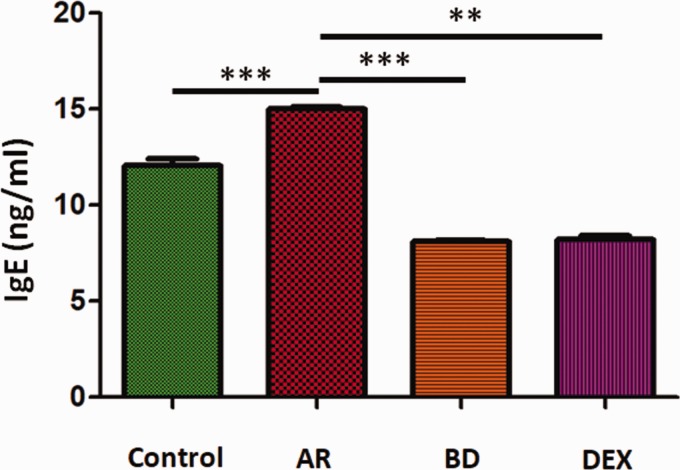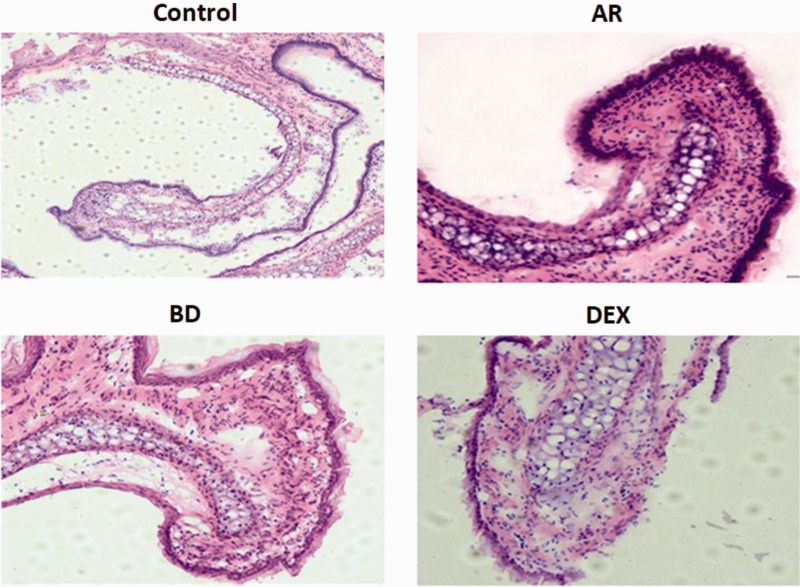Effect of Biospray Dressings on Eosinophil Infiltration in the Nasal Mucosa and Serum IgE Levels After Nasal Provocation in Experimental Allergic Rhinitis.
IF 1.2
Q1 OTORHINOLARYNGOLOGY
引用次数: 2
Abstract
Purpose To investigate the effect of biospray dressing on the extent of eosinophil infiltration in the nasal mucosa and the level of serum IgE in experimental allergic rhinitis with nasal provocation. Method Twenty-four BALB/c mice were randomly divided into the normal control group, allergic rhinitis (AR) group, dexamethasone (DEX) treatment group, and biospray dressing (BD) group. The mice in the latter 3 groups were prepared for animal models of AR according to standard protocols. Mice in the BD group were administered a nasal spray before the nasal provocation, and those in the DEX group were administered an intraperitoneal injection of DEX. The nasal mucosa and serum were collected from each group. Nasal mucosa eosinophil infiltration was evaluated using hematoxylin and eosin staining, and enzyme-linked immunosorbent assay (ELISA) was performed to analyze the serum IgE expression. Results Eosinophil infiltration (AR vs BD P = .009) in the nasal mucosa and serum IgE expression (AR vs BD P = .001) were significantly lower in the BD group than in the AR group. There were no significant differences in the extent of eosinophil infiltration in the nasal mucosa or serum IgE expression between the BD and DEX groups. Conclusion Biospray dressings can significantly reduce allergen provocation in the nasal cavity and have a protective effect on the nasal mucosa. They can be used for the prevention and treatment of AR.



生物喷雾敷料对实验性变应性鼻炎鼻腔刺激后鼻黏膜嗜酸性粒细胞浸润及血清IgE水平的影响。
目的:探讨生物喷雾敷料对实验性变应性鼻炎鼻黏膜嗜酸性粒细胞浸润程度及血清IgE水平的影响。方法:将24只BALB/c小鼠随机分为正常对照组、变应性鼻炎(AR)组、地塞米松(DEX)治疗组和生物喷雾敷料(BD)组。后3组小鼠按标准方案制备AR动物模型。BD组小鼠在鼻腔刺激前鼻腔喷雾剂,DEX组小鼠在鼻腔刺激前腹腔注射DEX。采集各组大鼠鼻黏膜及血清。采用苏木精染色、伊红染色检测鼻黏膜嗜酸性粒细胞浸润情况,ELISA检测血清IgE表达。结果:BD组鼻黏膜嗜酸性粒细胞浸润(AR vs BD P = 0.009)、血清IgE表达(AR vs BD P = 0.001)明显低于AR组。BD组与DEX组大鼠鼻黏膜嗜酸性粒细胞浸润程度及血清IgE表达差异无统计学意义。结论:生物喷雾敷料能明显减少鼻腔内过敏原的激发,对鼻黏膜有保护作用。它们可用于预防和治疗AR。
本文章由计算机程序翻译,如有差异,请以英文原文为准。
求助全文
约1分钟内获得全文
求助全文

 求助内容:
求助内容: 应助结果提醒方式:
应助结果提醒方式:


